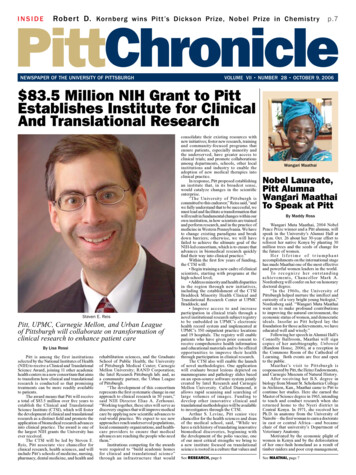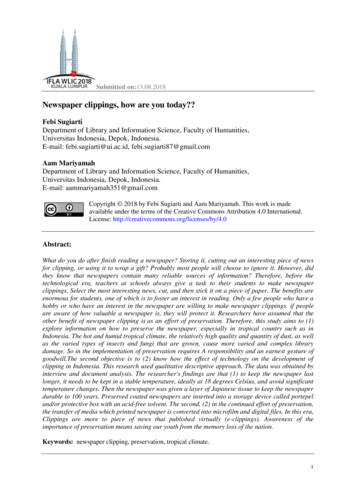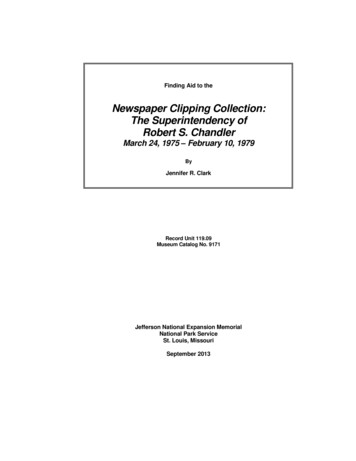
Transcription
INSIDERobert D. Kornberg wins Pitt’s Dickson Prize, Nobel Prize in Chemistr yNEWSPAPER OF THE University of Pittsburghp.7VOLUME VII NUMBER 28 OCTOBER 9, 2006 83.5 Million NIH Grant to PittEstablishes Institute for ClinicalAnd Translational ResearchSteven E. ReisPitt, UPMC, Carnegie Mellon, and Urban Leagueof Pittsburgh will collaborate on transformation ofclinical research to enhance patient careBy Lisa RossiPitt is among the first institutionsselected by the National Institutes of Health(NIH) to receive a Clinical and TranslationalScience Award, joining 11 other academichealth centers in a new consortium that aimsto transform how clinical and translationalresearch is conducted so that promisingtreatments can be more readily availableto patients.The award means that Pitt will receivea total of 83.5 million over five years toestablish the Clinical and TranslationalScience Institute (CTSI), which will fosterthe development of clinical and translationalresearch as a distinct field and promote theapplication of biomedical research advancesinto clinical practice. The award is one ofthe largest NIH grants the University hasever received.The CTSI will be led by Steven E.Reis, Pitt associate vice chancellor forclinical research, health sciences, and willinclude Pitt’s schools of medicine, nursing,pharmacy, dental medicine, and health andrehabilitation sciences, and the GraduateSchool of Public Health; the Universityof Pittsburgh Medical Center; CarnegieMellon University; RAND Corporation;the Intel Research Pittsburgh lab; and, asa community partner, the Urban Leagueof Pittsburgh.“The development of this consortiumrepresents the first systematic change in ourapproach to clinical research in 50 years,”said NIH Director Elias A. Zerhouni.“Working together, these sites will serve asdiscovery engines that will improve medicalcare by applying new scientific advances toreal-world practice. We expect to see newapproaches reach underserved populations,local community organizations, and healthcare providers to ensure that medicaladvances are reaching the people who needthem.”Institutions competing for the awardswere required to “build academic homesfor clinical and translational science”through an infrastructure that wouldconsolidate their existing resources withnew initiatives; foster new research, trainingand community-focused programs thatensure patients, especially minority andthe underserved, have greater access toclinical trials; and promote collaborationsamong departments, schools, other localinstitutions and industry to enable theadoption of new medical therapies intoclinical practice.In response, Pitt proposed establishingan institute that, in its broadest sense,would catalyze changes in the scientificenterprise.“The University of Pittsburgh iscommitted to this endeavor,” Reiss said, “andwe fully understand that to be successful, wemust lead and facilitate a transformation thatwill result in fundamental changes within ourown institution, in how scientists are trainedand perform research, and in the practice ofmedicine in Western Pennsylvania. We haveto change existing paradigms and breakdown barriers; otherwise, we will havefailed to achieve the ultimate goal of theNIH-led consortium, which is to ensure thatadvances in biomedical research quicklyfind their way into clinical practice.”Within the first few years of funding,the CTSI will: Begin training a new cadre of clinicalscientists, starting with programs at thehigh-school level; Address minority and health disparitiesin the region through new initiatives,including the establishment of the CTSIBraddock Minority Health Clinical andTranslational Research Center at UPMCBraddock; and Improve access to and increaseparticipation in clinical trials through anovel institutional research subject registryto be embedded in UPMC’s electronichealth record system and implemented atUPMC’s 350 outpatient practice locationsand 19 hospitals. The registry will enablepatients who have given prior consent toreceive comprehensive health informationand educational materials and to be offeredopportunities to improve their healththrough participation in clinical research.The CTSI also will enable the launchof novel methodologies. One applicationwill evaluate breast lesions depicted onmammograms and pathology slides basedon an open-source software system jointlycreated by Intel Research and CarnegieMellon University. Called Diamond, itallows rapid scanning and searching oflarge volumes of images. Funding todevelop other innovative clinical andtranslational methodologies will be availableto investigators through the CTSI.Arthur S. Levine, Pitt senior vicechancellor for the health sciences and deanof the medical school, said, “While wehave a rich history of translating innovativebiomedical discoveries, beginning withthe development of the polio vaccine, oneof our most critical strengths we bring toa new institute focused on translationalscience is rooted in a culture that values andSee RESEARCH, page 6Wangari MaathaiNobel Laureate,Pitt AlumnaWangari MaathaiTo Speak at PittBy Maddy RossWangari Muta Maathai, 2004 NobelPeace Prize winner and a Pitt alumna, willspeak in the University’s Alumni Hall at6 p.m. Oct. 26 about her 30-year effort toreforest her native Kenya by planting 30million trees and the seeds of change forthe future of women.Her lifet i me of t r iu mphantaccomplishments on the international stagehas made Maathai one of the most effectiveand powerful women leaders in the world.To r e c og n i z e h e r o u t s t a n d i n gach ievement s, Cha ncellor Ma rk A.Nordenberg will confer on her on honorarydoctoral degree.“In the 1960s, the University ofPittsburgh helped nurture the intellect andcuriosity of a very bright young biologist,”Nordenberg said. “Wangari Muta Maathaiwent on to make profound contributionsto improving the natural environment, theeconomic status of women, and democraticideals. Insofar as Pitt helped lay thefoundation for those achievements, we haveeducated well and wisely.”Following her speech in Alumni Hall’sConnolly Ballroom, Maathai will signcopies of her autobiography, Unbowed(Random House, 2006), at a reception inthe Commons Room of the Cathedral ofLearning. Both events are free and opento the public.Ma athai’s visit to Pit tsbu rgh iscosponsored by Pitt, the Heinz Endowments,and Carnegie Museum of Natural History.After receiving her B.S. degree inbiology from Mount St. Scholastica Collegein Atchison, Kan., Maathai came to Pitt tocontinue her studies. Here she earned theMaster of Science degree in 1965, intendingto teach and conduct research when shereturned home to the Nyeri district inCentral Kenya. In 1971, she received herPh.D. in anatomy from the University ofNairobi—the first woman to earn a doctoratein east or central Africa—and becamechair of that university’s Department ofVeterinary Anatomy.Motivated by the economic plight ofwomen in Kenya and by the deforestationof her once-lush homeland as a result oftimber raiders and poor crop management,See MAATHAI, page 7
Pitt Chronicle October 9, 2006Pitt HostingLecture bySallie HughesBrieflyNOTEDSa l l ie Hu g he s ,author of NewsroomsinConf lict:Journalism and theDemocratization ofMexico (University ofPittsburgh Press, 2006),will deliver a lectureat Pitt about changesin the Mexican mediaduring that country’st r a nsfor mat ion todemocracy, at noontoday in 4130 PosvarHall. Hughes receivedthe GoldsmithResearch Award fromthe Shorenstein Centeron the Press, Politics,and Public Policy atHar vard Universityfor research used inthe preparation of thisbook.Hughes is ana ssist a nt professorof jou r n a l i s m a n dphotog raphy at theUniversity of Miami.Prior to receiving her Ph.D. in LatinA me r ica n St ud ie s f rom Tu la neUniversity in 2001, she worked as areporter; her articles were published inThe Miami Herald and The WashingtonPost, among other publications.The event is sponsored by Pitt’sCenter for Latin American Studies(CLAS) and the University of PittsburghPress. For more information, contactCLAS at 412-648-7392 or clas@ucis.pitt.edu.—Amanda LeffPitt Seven-Week CourseWill Foster ResearchEntrepreneurshipThe University’s Office of theProvost and Office of TechnologyManagement, in conjunction withthe Joseph M. Katz Graduate Schoolof Bu si ne s s a nd it s Ce nt e r forExecutive Education, are hosting aseven-week course titled “AcademicEntrepreneurship: The Business ofCommercial Innovation.”Designed to foster the developmentof research into commercially viableinnovations, the course begins Oct.16.It will be held every Monday throughNov. 20, 6-9 p.m., in 528 Alumni Hall.The program will culminate Dec. 1,with an all-day program, includingan innovation-application workshop,graduation ceremony, and reception.The course will expose researchfaculty and their graduate assistants tothe environment of entrepreneurship andcommercial innovation. The course willshow how academic entrepreneurshipcan lead to a better understandingof market challenges and solutions,marketability, collaboration, and—ultimately—successful technologytransfer.The course begins with the root ofentrepreneurship—idea conception—and extends through lateral thinkingtechniques, intellect ual proper typrotection and licensing, early-stagemarket research, strategic peoplenetwork development, and marketingand com mu nications packagi ng.Instructors will encourage applicationof solid business principles to theattendee’s own innovation ideas.Participants’ course fees will bepaid for by Pitt’s Office of the Provost.To register, contact Dan Bates at 412624-4474 or dbates@provost.pitt.edu.—Mary ZangrilliUniversity SponsoringAmerica on the Move WalkPitt will again host America on the Movein Pittsburgh in an effort to get Pittsburghersup and moving. The second in a series, thisfree event will take place, rain or shine, atnoon Oct. 11, beginning and ending at theSchenley Plaza Tent in Oakland.The walk is expected to take 20-25minutes. The first 1,000 participants willreceive free America on the Move inPittsburgh long-sleeved T-shirts.Pitt Chancellor Mark Nordenberg andUPMC Health Plan President Diane Holderwill address participants prior to the walk.It will begin at 12:15 p.m., led by LeslieSansone, “In-Home Walking” programoriginator and owner of Studio Fitnessin New Castle, and Jennifer Antkowiak,formerly with KDKA-TV and now executivedirector of promotions, marketing, andmultimedia for Sansone.Pittsburghers can register for Americaon the Move at www.americaonthemove.orgor by calling 1-888-553-8762.UPMC Health Plan members canreceive additional benefits for participating.These individuals should enter the code“UPMC” as the Group Registration Codeon the registration pages, and then enter theUPMC Health Plan ID number from theirhealth plan card when prompted.For more information, contact thedirector of America on the Move inPittsburgh, John M. Jakicic, chair of Pitt’sDepartment of Health and Physical Activity,at 412-488-4182 or jjakicic@pitt.edu.—Audra SormanOct. 12 Nordenberg LectureTo Focus on “AutonomyAnd Profoundly MentallyDisabled Persons”Norman L. Cantor, professor of lawemeritus and Nathan Jacobs DistinguishedScholar at Rutgers University School of Law,Newark, will deliver the annual Mark A.Nordenberg Lecture in Law and Psychiatryat noon Oct. 12 in the Barco Law Building’sTeplitz Memorial Courtroom.Cantor’s free public lecture is titled“Autonomy and Profoundly MentallyDisabled Persons.”Cantor, who joined Rutgers faculty in1970 and became professor emeritus in 2005,taught in such diverse areas as constitutionallaw, labor law, contracts, and bioethics. Hehas written three books: Making MedicalDecisions for the Profoundly MentallyDisabled (The MIT Press, 2005), AdvanceDirectives and the Pursuit of Death withDignity (Indiana University Press, 1993),and Legal Frontiers of Death and Dying(Indiana University Press, 1987).The lecture, named after Pitt ChancellorMark A. Nordenberg, former dean of thelaw school, is approved by the PennsylvaniaContinuing Legal Education (CLE) Boardfor one hour of substantive CLE credit. Formore information, contact Matt Moon at412-648-1320 or mmoon@law.pitt.edu orvisit www.law.pitt.edu/academics/cle.php.—Audra SormanPitt Festival Will ScreenTurkmen, Kazakh FilmsPitt’s Department of Slavic Languagesand Literatures, Center for Russian and EastEuropean Studies, and Film Studies Programwill present “Cine-stan: Turkmen andKazakh Films,” a festival of contemporaryfilms from Turkmenistan, all of which areU.S. premiers, Oct. 12-26.As part of the festival, Martha BrillOlcott, a senior associate with the Russianand Eurasian Program at the CarnegieEndowment for International Peace inWashington, D.C., will give a talk titled“Central Asia: Strategic Ally or SecurityRisk?” at 4:30 p.m. Nov. 2 in 4130 PosvarHall.“Filmmaking in Turkmenistan has beenNOCTURNAL WANDERER A colorful cast of strangers portrayed by (from left)Brenden Gallagher, Parag S. Gohel, Brittany Andrews, Nate Jedrzejewski, and AndyRis inhabit the dangerous streets of urban China in Gao Xingjian’s Nocturnal Wanderer,a dreamlike tale of brutality, isolation, and blame. Pitt Repertory Theatre’s productioncontinues through Oct. 15 in the Studio Theatre, located in the basement (B-72) ofthe Cathedral of Learning. For ticket information, call 412-624-PLAY (7529) or visitwww.play.pitt.edu.virtually banned since Saparmurat Niyazovconsolidated power after the collapse ofthe Soviet Union,” said Vladimir Padunov,associate director of Pitt’s Film StudiesProgram. “All filmmakers fled the countryin the years leading up to 1997, the yearthe last feature film was made at TurkmenFilm Studios and also the year that Niyazovbuilt a new highway where the film studioonce stood.”The films featured in the festival rangefrom Khodjakuli Narliev’s Daughter-inLaw (1971), in which a woman waits in theTurkmen desert dreaming of her missinghusband, a pilot in the Soviet Air Forceduring WWII, to Murad Aliev’s Aura, apolemic dramatization of the narcoticsbusiness in Central Asia.All films will be shown at 8 p.m. inBellefield Hall’s screening room. Admissionis free.Screening dates, the films, and theirdirectors follow:Oct. 12—Daughter-in-Law (1971),directed by Khodjakuli Narliev;Oct. 13—Mankurt (1990), directed byKhodjakuli Narliev;Oct. 19—The Education of a Man(1982), directed by Usman Saparov andIazgeldy Seidov;Oct. 20—The Son (1989), directed byKhalmamed Kakabaev; andOct. 26—Short films: Aura (1987),directed by Murad Aliev (whichwas shelved and later destroyed inTurkmenistan); Summer Heat (1988),directed by Darezhan Omirbaev;and Toro (1986), directed by TalgatTemenov.For more information, visit: www.pitt.edu/ filmst/events/TurkmenFilmSeries/index.htm.—Mary ZangrilliTomorrow Is Deadline forRegistering to Vote Nov. 7Tomorrow at 5 p.m. is the deadline fornew voters to register to vote in the Nov. 7general election.Individuals who have never registered before, who have changed names oraddresses since registering, or who wishto change political party affiliation mustsubmit voter registration forms to theAllegheny County Board of Elections at604 County Office Building, 542 ForbesAve., Pittsburgh 15219; 412-350-4510.Forms for voter registration areavailable at Pitt’s Office of Community and Governmental Relations(710 Alumni Hall) as well as at statedriver’s license centers, state liquorstores, libraries, municipal buildings,post offices, some banks, and the Boardof Elections. Forms may be obtainedonline at www.dos.state.pa.us.Applications for absentee ballotsfor the Nov. 7 general election must bereceived by the county Board of Elections by Nov. 3 at 5 p.m.PittChronicleNewspaper of the University of PittsburghPUBLISHERRobert HillASSOCIATE PUBLISHERJohn HarvithEXECUTIVE EDITORLinda K. SchmitmeyerEDITORBruce SteeleINTERIM ART EDITORGary CravenerSTAFF WRITERSSharon S. BlakeJohn FedeleKaren HoffmannAmanda LeffPatricia Lomando WhiteCONTRIBUTING WRITERSJocelyn Uhl Duffy, Gloria Kreps,Maddy Ross, Lisa Rossi,Kelly Shaffer, Audra Sorman,Elizabeth Strohm, Mary ZangrilliHAPPENINGS EDITORDylan NicePitt Chronicleis published throughout the year byUniversity News and MagazinesUniversity of Pittsburgh400 Craig HallPittsburgh, PA 15260Phone: 412-624-1033Fax: 412-624-4895E-mail: chron@pitt.eduWeb: www.umc.pitt.edu/media/pcc/The University of Pittsburgh is an affirmativeaction, equal opportunity institution that does notdiscriminate upon any basis prohibited by law.
October 9, 2006 University of Pittsburgh Documenting PittNew Pitt Web site offersaccess to 70,000 pages oftext, photos, yearbooks,dating back to 19th centuryBy Sharon S. BlakeCurious to see what grandpa lookedlike when he was a student at the Universityof Pittsburgh? Wondering what coursesPitt offered in the 1800s? A new Web sitebeing launched today by Pitt’s UniversityLibrary System (ULS) is providing quickand easy online access to a treasure troveof materials stored in the UniversityArchives.Called Documenting Pitt: HistoricalPublications and Images of the Universityof Pittsburgh ), the site enablesusers to search and browse through assortedathletic media guides, chancellors’ reports,commencement programs, fact books,University catalogs, yearbooks, and otherPitt-produced publications.The ULS Digital Research Library,with financial support from the Office ofthe Provost, digitized more than 70,000pages of text and images in creating thenew site.University archivist Marianne Kasicasays Documenting Pitt will make it easierfor her to respond to frequent requests forissues of The Owl, the yearbook publishedby Pitt from 1907 to 1980. (Since then,Panther Prints has been the Pitt yearbook’stitle.) “It seems that not a day goes by inthe archives without someone requestinga yearbook page or material about theUniversity,” Kasica said.“Now that this corpus of Pitt history isavailable online, our patrons can search anddiscover important sources of institutionalhistory they may have overlooked before,”added University Librarian Rush Miller,director of ULS.Visitors to the site can search andClockwise from top left: Forbes Avenue duringthe 1930s, and 1950s photos of members ofThe Pitt News staff and the University’sstudent government organization.browse through more than seven decadesworth of The Owl yearbooks as well asissues of the University Courant, a lesserknown periodical featuring poems andessays written by students, faculty, andadministrators, published by Pitt in the late19th and early-20th centuries.The text collections also containmaterials written about Pitt, ranging froma 1901 speech by Chancellor William J.Holland to the more recent Pitt: The Storyof the University of Pittsburgh by RobertC. Alberts (University of Pittsburgh Press,1986). The site includes many images thatwere already digitized as part of Pitt’sHistoric Pittsburgh Image CollectionsWeb site (http://images.library.pitt.edu/pghphotos) but are now accessible throughthe Documenting Pitt site.Pitt Vice Chancellor Robert Hill Named 2006 BusinessCommunicator of the Year by IABC’s Pittsburgh ChapterHill to be honoredduring Oct. 26 GoldenTriangle Awardsprogram in Oaklandprofessional business communications inWestern Pennsylvania.“In this age of information overload,strategic communication leadership is moreimportant than ever,” said Tina Jerzyk,copresident of IABC/Pittsburgh. “TheBusiness Communicator of the Year awardcelebrates one individual’s ability to createRobert Hill, Pitt vice chancellor and implement strategies that shape actions,for public affairs, will receive the opinions, and attitudes.”2006 Business Communicator of theHill will be presented with the 3rdYear Award from the Pittsburgh chap- annual Business Communicator of theter of the InternationalYear Award Oct. 26 duringAssociation of BusiIABC/Pittsburgh’s 27th annualness CommunicatorsGolden Triangle Awards pro(IABC).gram at the Twentieth Century“With so many outClub in Oakland. Also duringstanding communicatorsthe program, members of Hill’sin Pittsburgh, I feel trulyOffice of Public Affairs staffhonored to be namedwill receive 27 awards forIABC/Pittsburgh’s Busiwriting, publications and Webness Communicator ofdesign, media relations, andthe Year,” Hill said. “Thisother communications work.selection is ironic in thatReservations are available atmy superb staff, whomwww.iabcpittsburgh.com.I drive to near-collapseA spokesperson for theRobert Hillon every project, wouldindependent panel of seniorreinforce that maniacal behavior by IABC/Pittsburgh communicators whonominating me for this award.”reviewed 2006 Business Communicator ofIABC/Pittsburgh created its the Year Award nominees stated, “ThroughBusiness Communicator of the Year out Robert’s communications career, he hasAward in 2004 to recognize individu- consistently been driven to excellence. Thisals for outstanding contributions in drive has been accompanied by a strongpracticing, promoting, and enhancing desire to mentor young professionals. Infact, several previous students were amongthe many who nominated him for this year’shonor.“As vice chancellor and the University’schief spokesperson, Robert has fosteredgreater understanding of Pitt’s ever-broadening range of accomplishments and itsgrowing reputation,” the selection panel’sspokesperson continued. “Robert has donethis by building a multitalented staff whoseexpertise is evidenced by the more than450 awards and recognitions garnered forpublications and other initiatives. Onecontribution of particular note is the multiinstitutional taskforce that Robert assembled[in 2001] to provide and promote measlesvaccinations for young children. Few communications professionals have been able torealize the success that Robert has enjoyed.Robert’s dedication to his community, hisuniversity, and his profession make him amost deserving recipient of this honor fromIABC.”Hill has led Pitt’s Office of PublicAffairs since 1999, and has served as vicechancellor for public affairs since 2001. Heis responsible for the University’s overallcommunications strategy, news and information, national media relations, publications,marketing communications, Web site development and administration, institutionaladvertising, video communications, chancellor’s communications, printing services,and University spokesperson duties.Hill is credited with expandingand reorganizing the University’spublic affairs office, establishingPitt’s first official weekly newspaper,supervising the redesign of the University’s Web presence, and leadingan unprecedented rise in the standardsof news, writing, design, publications,and video productions.In addition to his official duties,Hill has shared his communicationsexpertise with community organizations including the Urban League ofPittsburgh, Three Rivers Youth, theGreater Pittsburgh YWCA, and thePennsylvania Black Conference onHigher Education.An alumnus of New York University’s Stern School of Business,Hill holds a Master of Science inManagement with Honors fromManhattan College, and a Certificatein Management from Harvard University.Prior to joining Pitt, he served asSyracuse University’s vice presidentfor public relations for 10 years,during which his department won theprestigious Gold Medal for OverallInstitutional Relations Programsfrom the Council for Advancementand Support of Education, the highestpublic relations award in Americanhigher education.
Pitt Chronicle October 9, 2006PHOTOS.COMPHOTOS.COMNIH Grants Pitt’s Medical School 8.4 MTo Determine Best Treatments for SepsisBy Jocelyn Uhl DuffySepsis is among the top causes of deathin the United States, affecting 750,000Americans each year, 30 percent of whomdie. It also is one of the most expensivediseases, with a cost to U.S. hospitals of 17 billion each year. To investigate anddetermine the best methods for treatingsepsis, the National Institute of GeneralMedical Sciences (NIGMS), one of theNational Institutes of Health, has awarded an 8.4 million, five-year grant to Pitt’s Schoolof Medicine to head a multidisciplinary,multicenter consortium.The Protocolized Care for Early SepticShock (ProCESS) study will attempt todetermine if there is a “golden hour” in themanagement of sepsis and septic shock whena prompt, rigorous, standardized treatmentregimen can be used to improve clinicaloutcomes and halt the progression of eventsthat often lead to organ failure and death. Thestudy takes a cue from coronary care, whichhas significantly reduced mortality fromacute coronary diseases and dramaticallylowered the costs of care by determiningsuch best practices.The investigators, led by Derek C.Angus, professor and vice chair of researchin the Pitt medical school’s Department ofCritical Care Medicine, share a sense ofurgency about their research. They hopethat the project will generate useful andcomprehensive data on the clinical andbiological aspects of standardized treatmentfor septic shock—data that can havean immediate impact on, andimprove care of, the criticallyill.“While we havequite an extensiveunderstanding of thecauses and course ofsepsis, we have very littleempirical data telling ushow and when to treat thisterrible disease,” Angussaid. “Sepsis has reachedepidemic proportions in theUnited States, taking as manylives as heart attacks do. It isessential that we conduct this kind of studyto identify the ideal way to stop the rampantinflammation before it reaches the pointwhere it becomes so severe and aggressivethat it cannot be stopped.”“This project will examine whetherspecific treatments, if given early enough,can stop sepsis in its tracks,” said NIGMSDirector Jeremy M. Berg. “The goal is tospeed recovery, increase survival rates, andimprove the long-term quality of life forthose who have had sepsis.”Sepsis occurs when the body’sinflammatory response overreacts to aninfection, resulting in a cascade of eventsthroughout the body. The cascade beginswith septic shock, then vital organs becomecompromised, and the syndrome progressesto multiple organ failure and death.The trial, to be conducted at severalleading hospitals around the country, willenroll up to 2,000 participants who cometo emergency departments with septicshock. Participants will be randomizedto receive alternative treatment protocolsinvolving intravenous fluids, drugs thatreverse the shock, and hemodynamicmonitoring during the first six hours ofcare. The protocols will be evaluated onthree measures: clinical effectiveness asevidenced by improved mortality rates;effectiveness in reducing concentrationsof biological markers that are associatedwith the four fundamental pathways ofsepsis-related organ dysfunction—cellularhypoxia, oxidative stress, inflammationand coagulation/thrombosis; and costeffectiveness.Collaborations with emergency medicineexperts is critical. The researchers note thatgetting septic patients the correct care themoment they enter the hospital is essentialto the success of the treatment.“ProCESS will expand our understandingof emergency department sepsis care andcould revolutionize that care,” said DonaldM. Yealy, professor and vice chair in the Pittmedical school’s Department of EmergencyMedicine and coprincipal investigator ofthe study. “We will be able to betterunderstand what type of careworks and why, and improvethe link between emergencyand ICU care. We hope tosave lives, starting at the‘front’ door.”“This collaborativemodel is one that theUniversity of Pittsburghhas championed for years.Carrying out this clinicalresearch is key to the missionof the department of critical caremedicine, the first such departmentof its kind in the country,” added MitchellP. Fink, professor and chair of critical caremedicine and Watson Professor of Surgery inthe Pitt medical school. “Bringing this modelto sites across the country could profoundlyimpact critical care at the national level.”“By improving the treatment of thosecritically ill with sepsis, the consortium’swork will have enormous implications forthe thousands of patients who suffer fromthis infection,” said NIH Director Elias A.Zerhouni.Pitt’s Brain Trauma Research CenterReceives 6.3M Renewal GrantBy Gloria KrepsThe University of Pittsburgh BrainTrauma Research Center (BTRC) has beenawarded a 6.3 million grant from theNational Institute of Neurological Disorders and Stroke of the National Institutes ofHealth (NIH) to continue research into theeffects of head injuries on the brain.BTRC researchers will investigate thefactors that often contribute to poor outcomes as well as new treatments that maylead to improved recovery for patients at alllevels of brain injury. The five-year grant isan extension of funding to the BTRC, an NIHCenter of Excellence originally establishedhere in 1991. The BTRC is housed in thePitt School of Medicine’s Department ofNeurological Surgery.“Traumatic brain injury is a huge publichealth problem for which there is no cure,”said BTRC Director Edward Dixon, whois also professor of neurological surgery,anesthesiology, neurobiology, and physicalmedicine and rehabilitation in Pitt’s medicalschool. “Since there are so few treatmentsfor brain trauma, our special focus is totranslate our research into practical, clinical approaches that can ultimately help thebrain-injured patients who are on the roadto recovery.”“This grant truly distinguishes us as oneof the leading centers in the world in braintrauma research and treatment,” said AminKassam, interim chair and associate professor in Pitt’s neurological surgery department. “This focused and concerted effortlays the foundation for better understandingof trauma to the central nervous system,enabling us to develop treatment strategiesthat will make a difference.”Since establishment of the BTRC in1991, Pitt researchers have made groundbreaking contributions to the understandingof how head trauma damages the brain andhow damage progresses during the first fewhours and days following injury. BTRC-ledresearch has resulted in more
include Pitt's schools of medicine, nursing, pharmacy, dental medicine, and health and 83.5 Million NIH Grant to Pitt Establishes Institute for Clinical And Translational Research Pitt, UPMC, Carnegie Mellon, and Urban League of Pittsburgh will collaborate on transformation of clinical research to enhance patient care











